Buckley Class Line Drawings
Buckley Class Line Drawings
- ※データは護衛駆逐艦バックリー級の項を参照
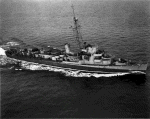 |
フランシス M. ロビンソン Francis M. Robinson(DE-220)。1番50口径3インチ砲。型式名はMk. 21もしくはMk.
22両用砲。マウント(砲架)名はMk. 22。アメリカ海軍にて駆逐艦と同様、護衛駆逐艦の主砲は前から順にNo. 31/32/33・・・と名称。No.
31は“3インチ1番砲”の意味 02 February 1944: USS Francis M. Robinson (DE 220) underway. (U.S. Navy photo #80-G-215506 from the National Archives and Records Administration, College Park, Md.). Image courtesy of NavSource. |
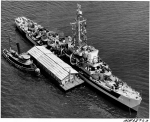 |
フォラー Fowler(DE-222)。3インチ1番砲の直後にあるのはヘッジホッグMk. 10。イギリス海軍が開発したモデルのアメリカ版。弾薬庫は後方の甲板室左舷側にあり、通常6斉射分(144発)を搭載。マストの両脇に伸びているのはフォアマスト・ヤード。両端にIFF応答用のBKアンテナ、その内側に点滅信号灯を装備。左舷側にはTBS無線アンテナ。フォアマスト・ヤードの上の白い丸いドーム状のはSL対水上レーダー。SGを小型化して護衛駆逐艦以下の小艦艇に搭載可能としたもの。浮上潜水艦の探知可能距離は10浬。レドーム内部に幅42㎝(1.05m)のアンテナを収容 22 July 1944: Sandy Hook Bay, N.J. - A five view series of USS Fowler loading ammunition from barges at the Naval Ammunition Depot, Earle, N.J. On the previous day, 21 July, Fowler had completed a nine day yard availability period at the New York Navy Yard in Brooklyn, N.Y. (U.S. Navy photos #'s19-N-68765, 19-N-68764, 19-N-68766, 19-N-68762, 19-N-68763 from the National Archives and Records Administration, College Park, Md.; courtesy of Chris Wright). Image courtesy of NavSource. |
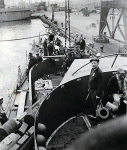 |
リーヴス Reeve(DE-156)。2番50口径3インチ砲。No. 32のブルワークの内側に砲員用のヘルメットが格納。砲は人力操作の為、射界制御装置が付く 04 October 1943: New York Navy Yard, Brooklyn, N.Y. - A yard worker standing in the gun tub of Mount 32 looks up at the photographer. View of USS Reeves (DE 156) during her first yard availability. A yard worker standing in the gun tub of Mount 32 looks up at the photographer. Image courtesy of NavSource. |
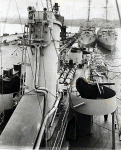 |
リーヴス Reeve(DE-156)。煙突の後ろにあるのは21インチ3連装魚雷発射管Mk. 14。連管に数に関係なく、ブラスト・フードのあるものをMk.
15、無いものをMk. 14と呼ぶ 04 October 1943: New York Navy Yard, Brooklyn, N.Y. - A yard worker standing in the gun tub of Mount 32 looks up at the photographer. View of USS Reeves (DE 156) during her first yard availability. Looking aft from the port side of the bridge. Image courtesy of NavSource. |
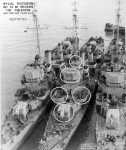 |
メア・アイランド海軍工廠にて停泊中のダービー Darby(DE-218)。ダービーを中心に向かって右はハーモン Harmon(DE-678)、左はクールバーグ
Coolbaugh(DE-217)。海軍艦船局(Bureau of Ships: BuShips)のエドワード L. コクレーン大佐 Captain Edward L. Cochrane推奨のイギリス式露天艦橋(オープン・ブリッジ)。艦橋両舷のウィングには各2基の見張り員席(スカイルックアウト・チェア)があり、前方が水上、後方が対空見張り用。ウィンドスクリーンから前の閉囲された区画はソナー室でそこから1デッキ下、丸窓の並ぶ所が操舵室(パイロットハウス)。露天艦橋は窓枠や天井等視界を遮るのもの無いので全周の視界を確保出来る。対空警戒だけでなく、船団護衛の際には各船の動きを把握出来る 15 November 1945: Mare Island Navy Yard, San Francisco, Cal. - Forward plan view of J. Douglas Blackwood at Mare Island. USS Darby (DE 218) is inboard and USS Harmon (DE 678) is outboard of USS Coolbaugh (DE 217) in the background. (U.S. Navy photo #DE-219-7190-45). Image courtesy of NavSource. |
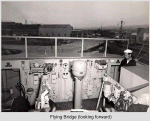 |
シムス Sims(DE-154)の露天艦橋内。フライング・ブリッジ(前方) USS Sims (DE 154) circa 1943 - 1944: A ten view series of various spaces in the ship's bridge area. (Photos from Warren J. Lusk, Ken's Dad, who was a Sims plankowner. Enlisting in the Navy on 12 December 1942 at St. Louis, Mo.; he reported aboard Sims on 24 April 1943 as a Seaman 2nd Class at the Norfolk Navy Yard. On 06 February 1946, he transferred off Sims as a Machinist Mate 2nd Class, destined for the Personnel Separation Center in St. Louis, Missouri.). Image courtesy of NavSource. |
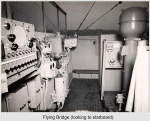 |
シムス(DE-154)の露天艦橋内。フライング・ブリッジ(右舷) USS Sims (DE 154) circa 1943 - 1944: A ten view series of various spaces in the ship's bridge area. (Photos from Warren J. Lusk, Ken's Dad, who was a Sims plankowner. Enlisting in the Navy on 12 December 1942 at St. Louis, Mo.; he reported aboard Sims on 24 April 1943 as a Seaman 2nd Class at the Norfolk Navy Yard. On 06 February 1946, he transferred off Sims as a Machinist Mate 2nd Class, destined for the Personnel Separation Center in St. Louis, Missouri.). Image courtesy of NavSource. |
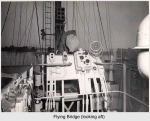 |
シムス(DE-154)の露天艦橋内。フライング・ブリッジ(後方) USS Sims (DE 154) circa 1943 - 1944: A ten view series of various spaces in the ship's bridge area. (Photos from Warren J. Lusk, Ken's Dad, who was a Sims plankowner. Enlisting in the Navy on 12 December 1942 at St. Louis, Mo.; he reported aboard Sims on 24 April 1943 as a Seaman 2nd Class at the Norfolk Navy Yard. On 06 February 1946, he transferred off Sims as a Machinist Mate 2nd Class, destined for the Personnel Separation Center in St. Louis, Missouri.). Image courtesy of NavSource. |
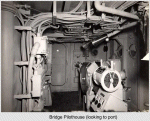 |
シムス(DE-154)の露天艦橋内。操舵室(パイロットハウス、左舷) USS Sims (DE 154) circa 1943 - 1944: A ten view series of various spaces in the ship's bridge area. (Photos from Warren J. Lusk, Ken's Dad, who was a Sims plankowner. Enlisting in the Navy on 12 December 1942 at St. Louis, Mo.; he reported aboard Sims on 24 April 1943 as a Seaman 2nd Class at the Norfolk Navy Yard. On 06 February 1946, he transferred off Sims as a Machinist Mate 2nd Class, destined for the Personnel Separation Center in St. Louis, Missouri.). Image courtesy of NavSource. |
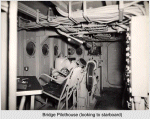 |
シムス(DE-154)の露天艦橋内。操舵室(パイロットハウス、右舷) USS Sims (DE 154) circa 1943 - 1944: A ten view series of various spaces in the ship's bridge area. (Photos from Warren J. Lusk, Ken's Dad, who was a Sims plankowner. Enlisting in the Navy on 12 December 1942 at St. Louis, Mo.; he reported aboard Sims on 24 April 1943 as a Seaman 2nd Class at the Norfolk Navy Yard. On 06 February 1946, he transferred off Sims as a Machinist Mate 2nd Class, destined for the Personnel Separation Center in St. Louis, Missouri.). Image courtesy of NavSource. |
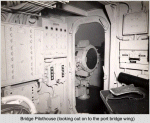 |
シムス(DE-154)の露天艦橋内。操舵室(パイロットハウス、左舷)。出入り口のは24インチ探照灯(サーチライト) USS Sims (DE 154) circa 1943 - 1944: A ten view series of various spaces in the ship's bridge area. (Photos from Warren J. Lusk, Ken's Dad, who was a Sims plankowner. Enlisting in the Navy on 12 December 1942 at St. Louis, Mo.; he reported aboard Sims on 24 April 1943 as a Seaman 2nd Class at the Norfolk Navy Yard. On 06 February 1946, he transferred off Sims as a Machinist Mate 2nd Class, destined for the Personnel Separation Center in St. Louis, Missouri.). Image courtesy of NavSource. |
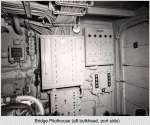 |
シムス(DE-154)の露天艦橋内。操舵室(パイロットハウス、後方隔壁、左舷) USS Sims (DE 154) circa 1943 - 1944: A ten view series of various spaces in the ship's bridge area. (Photos from Warren J. Lusk, Ken's Dad, who was a Sims plankowner. Enlisting in the Navy on 12 December 1942 at St. Louis, Mo.; he reported aboard Sims on 24 April 1943 as a Seaman 2nd Class at the Norfolk Navy Yard. On 06 February 1946, he transferred off Sims as a Machinist Mate 2nd Class, destined for the Personnel Separation Center in St. Louis, Missouri.). Image courtesy of NavSource. |
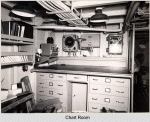 |
シムス(DE-154)の露天艦橋内。海図室 USS Sims (DE 154) circa 1943 - 1944: A ten view series of various spaces in the ship's bridge area. (Photos from Warren J. Lusk, Ken's Dad, who was a Sims plankowner. Enlisting in the Navy on 12 December 1942 at St. Louis, Mo.; he reported aboard Sims on 24 April 1943 as a Seaman 2nd Class at the Norfolk Navy Yard. On 06 February 1946, he transferred off Sims as a Machinist Mate 2nd Class, destined for the Personnel Separation Center in St. Louis, Missouri.). Image courtesy of NavSource. |
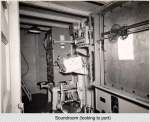 |
シムス(DE-154)の露天艦橋内。ソナー室(左舷) USS Sims (DE 154) circa 1943 - 1944: A ten view series of various spaces in the ship's bridge area. (Photos from Warren J. Lusk, Ken's Dad, who was a Sims plankowner. Enlisting in the Navy on 12 December 1942 at St. Louis, Mo.; he reported aboard Sims on 24 April 1943 as a Seaman 2nd Class at the Norfolk Navy Yard. On 06 February 1946, he transferred off Sims as a Machinist Mate 2nd Class, destined for the Personnel Separation Center in St. Louis, Missouri.). Image courtesy of NavSource. |
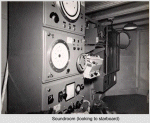 |
シムス(DE-154)の露天艦橋内。ソナー室(右舷) USS Sims (DE 154) circa 1943 - 1944: A ten view series of various spaces in the ship's bridge area. (Photos from Warren J. Lusk, Ken's Dad, who was a Sims plankowner. Enlisting in the Navy on 12 December 1942 at St. Louis, Mo.; he reported aboard Sims on 24 April 1943 as a Seaman 2nd Class at the Norfolk Navy Yard. On 06 February 1946, he transferred off Sims as a Machinist Mate 2nd Class, destined for the Personnel Separation Center in St. Louis, Missouri.). Image courtesy of NavSource. |
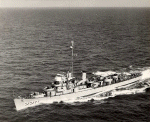 |
フランシス M. ロビンソン(DE-220)。操舵室出入り口に黒いカヴァーが掛けてあるのが24インチ探照灯(サーチライト)。その後ろの丸いのがスウィングアームに取り付けた12インチ信号灯(シグナルランプ)。ウィングの後方両舷には信号旗ロッカー(Flag
Box)がある 29 March 1949: Francis M. Robinson (DE 220) underway off Key West. (U.S. Navy photo #80-G-444114 from the National Archives and Records Administration, College Park, Md.). Image courtesy of NavSource. |
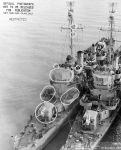 |
クールバーグ(DE-217)。クールバーグを中心に向かって右はJ. ダグラス・ブラックウッド J. Douglas Blackwood(DE-219)。フォアマスト・ヤードのてっぺんにはSA/SA-2/SA-3対空レーダー。CXAMを小型化したモデル。波長1.3m(Pバンド)のメートル波レーダー。SA-2/SA-3はPPI表示となり、電波妨害への対抗機能を備えた改良型。アンテナのサイズは全タイプ共通で2.85m×1.65m。水平方向にレーダー用ダイポール6本、垂直方向にIFF用ダイポール10本(BL及びBG用)を備える。フラットの左右には点滅信号灯(Blinker Light)がある。フォアマスト・ヤードの下側艦橋のすぐ上にある四角いボックス状は“ナンシー”赤外線(IR)通信システム発信機。その下の黒いカヴァーが掛かっているのが2.5m測距儀 15 November 1945: Mare Island Navy Yard, San Francisco, Cal - Forward plan view of USS Coolbaugh (DE 217) at Mare Island. USS J. Douglas Blackwood (DE 219) is inboard of Coolbaugh. (U.S. Navy photo #DE-217 7192-45). Image courtesy of NavSource. |
 |
フォアマン Foreman(DE-633)。フォアマスト・ヤードのすぐ下の両脇、ボックス状のものはファイティング・ライト(戦闘識別灯)。マストの左右両側に上下3基ずつ、計6基ある。水上戦闘艦に共通の装備だが、巡洋艦以上の大型艦では画像で確認するのが困難。色は上から赤・白・緑。夜戦の際、片舷3基のそれぞれ1色ずつを点灯、その組み合わせで味方を識別するという方式。フォアマスト・ヤードの下側艦橋のすぐ上にある四角いボックス状は“ナンシー”赤外線(IR)通信システム発信機 Another photo of USS Foreman (DE 633) taken during the same time period. Image courtesy of NavSource. |
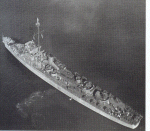 |
フォアマン(DE-633)。煙突(Stack)は角を丸めてあるが、遠路の断面は真四角 13 November 1943: Taken during USS Foreman's shakedown cruise. (U.S. Navy Photo #19-N-200662). Image courtesy of NavSource. |
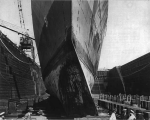 |
1944年5月~6月にチャールズタウン海軍工廠にて入渠中のバックリー Buckley(DE-51)。ドイツ海軍潜水艦U66と衝突したダメージが艦首に見える。因みに両舷のビルジキールの長さは94.5フィート。バックリー級を運用したイギリス海軍は最も不満としたのは、荒れた海上で周期の短い猛烈な横揺れ(ローリング)が発生する事だった。偶然にも冬期の北大西洋で起きる波の周期と、本級固有の横揺れ周期がシンクロしてしまった結果。吃水が深いのに上構重量が軽いのが問題だと考えた。イギリス海軍はビルジキールを後方へ14フィート延長して面積を増やした結果、横揺れが解消。アメリカ海軍側は改修しなかった。この画像からは見えないが、船体中心線上船首から25フィートの位置にあるのが、QCSもしくはQGBソナー。使用しない時は船体内に収容格納出来る昇降式 May-June 1944: Boston, Mass. - USS Buckley in drydock at the Boston Navy Yard, her bow bent from ramming U66. (Photo from Captain Jerry Mason, USN ret). Image courtesy of NavSource. |
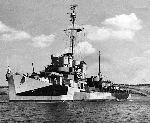 |
ジョセフ E. キャンベル Joseph E. Campbell(DE-70)。後部のマストはHF/DFマスト。トップのアンテナはアメリカ版のDAQという型。HF/DFは高周波/無線方位測定(High
Frequency/Radio Direction Finding)の略でハフ・ダフと読む。ヘッジホッグと同じくイギリスで開発。1942年3月から配備開始 USS Joseph E. Campbell (DE 70). Ireland 1943 (U.S. Navy Photo). Image courtesy of NavSource. |
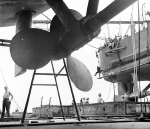 |
1945年7月にグアムの分割式浮きドックABSD-6にて入渠中のジョージ George(DE-697)。向こうは駆逐艦ティルマン Tillman(DD-641)。設計の途中で舵を中央1枚から並列2枚に改正した結果運動性が向上。旋回径は20ktで1,000フィートとなった。1枚舵の哨戒フリゲイト・タコマ級の旋回径は12ktで1,440フィート、駆逐艦フレッチャー級は30ktで1,850フィート July 1945: Guam, the Mariana Islands - USS George (DE 697) and USS Tillman (DD 641) are up on blocks in sectional floating drydock USS ABSD-6 while at the Fleet Anchorage prior to heading for Okinawa. (Photos by Life Magazine photographer J. R. Eyerman). Image courtesy of NavSource. |
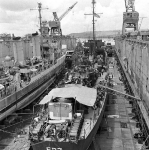 |
1945年7月にグアムの分割式浮きドックABSD-6にて入渠中のジョージ(DE-697)。左は駆逐艦ティルマン(DD-641)。ジョージの艦尾の中央の4連装の円筒形は煙幕発生器Mk. 1 Mod. 1。両側は爆雷投下軌条Mk. 10。爆雷を10発格納。その先、シートが被せている部分の右舷側に爆雷投射機Mk. 6。通称K-Gun。両舷4基ずつ計8基の装備数は哨戒フリゲイト・タコマ級と同じ。爆雷投射パターンは最大14発。通常は8斉射分112発の爆雷を搭載。Mk. 6はアーバー(投射箭)を使用する為に爆雷と同じ数が必要になり、投射機の近くにギッシリ格納されている。イギリス海軍は投射機を半数の4基とし、代わりに爆雷の搭載数を200発以上に増やして使用 July 1945: Guam, the Mariana Islands - USS George (DE 697) and USS Tillman (DD 641) are up on blocks in sectional floating drydock USS ABSD-6 while at the Fleet Anchorage prior to heading for Okinawa. (Photos by Life Magazine photographer J. R. Eyerman). Image courtesy of NavSource. |
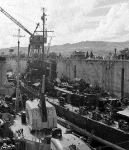 |
1945年7月にグアムの分割式浮きドックABSD-6にて入渠中のジョージ(DE-697)。手前は駆逐艦ティルマン(DD-641)。ティルマンの3番38口径5インチ砲の向こう側にジョージの1.1インチ4連装機関砲が見える。下の左舷側に爆雷投射機Mk. 6。通称K-Gun。当初の設計では大口径自動火器の装備はこの1ヶ所だけで、イギリス海軍風にX-positionと呼ばれた。バックリー級で40㎜機関砲を搭載して竣工した艦は2艦のみ。後に40㎜単装機関砲を4基追加で搭載し魚雷発射管を撤去した艦もある。イギリス艦はX-positionは空所か20㎜単装機関砲各1機装備した July 1945: Guam, the Mariana Islands - USS George (DE 697) and USS Tillman (DD 641) are up on blocks in sectional floating drydock USS ABSD-6 while at the Fleet Anchorage prior to heading for Okinawa. (Photos by Life Magazine photographer J. R. Eyerman). Image courtesy of NavSource. |
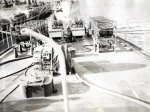 |
1944年1月13日にニュー・ヨークにて停泊中のチャールズ・ローレンス Charles Lawrence(DE-53)。チャールズ・ローレンスを艦尾に向かって見た構図で、艦尾の中央の4連装の円筒形は煙幕発生器Mk. 1 Mod. 1。両側は爆雷投下軌条Mk. 10。爆雷を10発格納 13 January 1944: Brooklyn, N.Y. - Two views of Charles Lawrence's stern taken while she was at the New York Navy Yard. Image courtesy of NavSource. |
Update 23/05/07